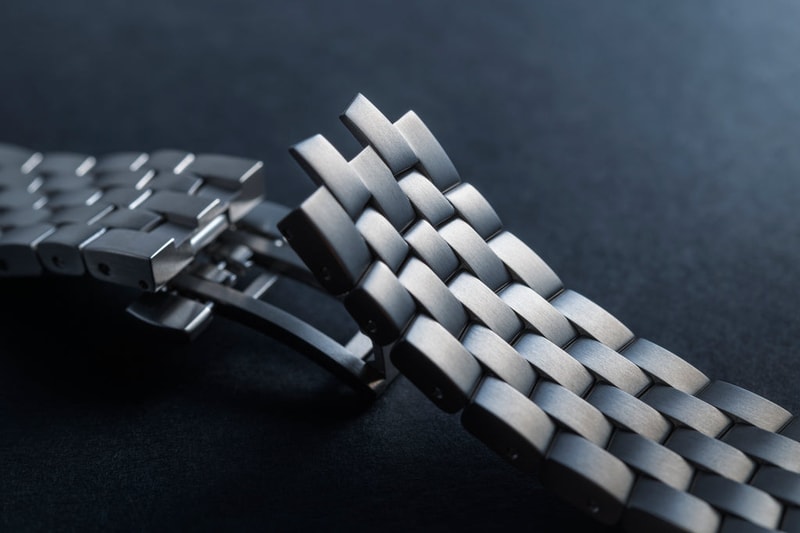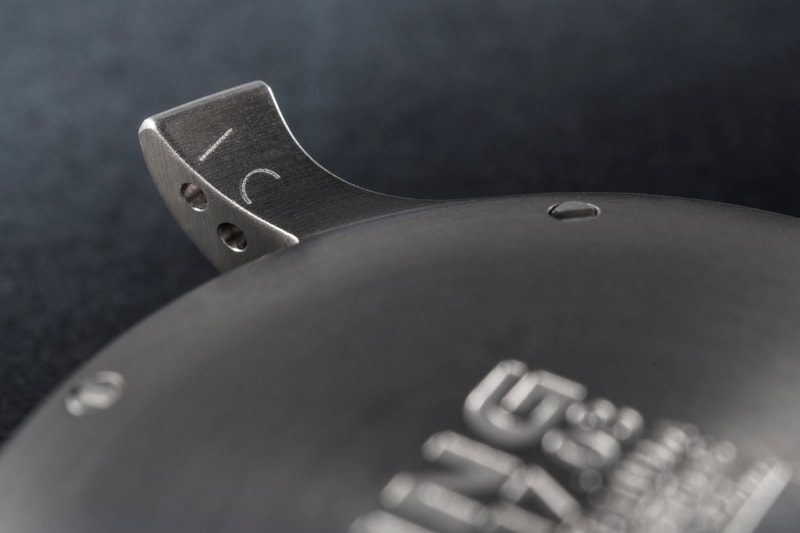
Most people don’t believe me when I say that our cost for the bracelet is actually higher than the case*, since for most people, the bracelet is merely an accessory. But think of it this way: our case is designed to be robust and simple, and only has five principal parts (bezel, band, back, crown tube, crown) and six screws.
*Excluding sapphire crystal.
The bracelet, on the other hand, has no fewer than one hundred and fifty six pieces as supplied. Each one of those pieces has to be finished to a tolerance of 20 microns in order to get the overall tolerances desired. A good bracelet has to ‘flow’ well, not pull hair, not flex laterally, be easy to adjust, be comfortable, be aesthetically pleasing, and be strong enough to resist the accidental tug of a two-year old. It should also feel solidly integrated with the case, but still be easy to remove and interchange for a strap. And did I mention the 17-series case has very short lugs, which further complicates things because of the required clearances for mounting?
Now I think you can see why designing a bracelet is something that’s far more complex than most people think, and extremely underrated.
In order to understand how we arrived at the 17.03’s bracelet design, we first have to understand the factors that affect wearing comfort. Wrists are not perfectly cylindrical, so a single rigid link across will never be as comfortable as a series of links with a little give that can conform to a wrist. Similarly, wrists are irregular in cross section, so you need to be able to move the more inflexible clasp piece around a bit for comfort. Yet if there’s too much give (the tolerances are usually in the pivot points), it results in hair pulling – hair gets stuck in the small crevices of the bracelet and pulled when your wrist flexes – and the links rotate against each other.
We decided therefore the best solution was to make a bracelet with a) short links to allow for maximum conformity; b) enough links laterally to allow for some play to conform to various wrists; c) not so many links as to feel loose, fragile or make manufacturing a pain; and a symmetric clasp that can be reversed to suit preferences in closing order. A slight angle was added to the links to mirror the arc of the case, and interlocking teeth on the clasp to ensure secure closure and eliminate another point of unwanted flex.
The result is a bracelet that has a huge number of articulation points, but only in one direction – increasing the thickness also helps to prevent unwanted motion in the wrong axis. For relative reference, we have a similar amount of lateral flex for a given length of bracelet to a popular premium brand’s three-link diver; except where they have four links and five articulation points, we have six links and no fewer than twenty five articulation points – that, and the photos below, should give you an idea of how tight our tolerances are. (For those wondering: there must be some gap between bracelet and lugs, else they will bind and not be removable).
It is also a massively adjustable bracelet – and if done properly, should make the 17.03 one of the most comfortable watches you can wear – both because of the flexibility of the bracelet, but also the balance of weight between head and clasp. Whole links are adjustable in approximately 7mm increments; the shorter solid links are approximately 5mm. This allows for net 2mm increments, and both sides are symmetric so you can easily interchange or flip them around – I personally wear 7.5 links on the 12 side, 6 on the 6 side, and close the 12 side first. Links are held by stainless steel screws, which can easily be adjusted using the included tool. When adjusted correctly, the clasp and watch should both sit centered on the bottom and top of your wrists, respectively. Furthermore, the overall length of the bracelet can be adjusted to accommodate for 136-225mm wrists (5.3-8.9”).
We’re particularly proud of the final piece of the puzzle: the quick-change feature. This required some clever engineering around the lugs to both maintain the visual proportions of the 17-series, but also accommodate both quick release curved straps as well as the straight-bar bracelet (or other third party straight bar straps), which is also quick release.
Firstly, there are two sets of holes in the lugs – marked with C and I to indicate which holes are for which type of bars. Next, there’s a slight cut in the caseback edge – this is both for the bracelet bar to clear the case and so thicker straps don’t land up chafing. Finally, the bracelet itself has a captive quick release pin built in: simply squeeze the two pegs and position the endpiece, give it a wiggle to seat, and ‘click!’ – no tools required.
Many brands in the past have shown us that a good bracelet is both an integral part of an iconic watch’s identity and a work of art in its own right. We really went to town (and gave our production partners hell) on the 17.03’s bracelet, and we hope you enjoy it as much as we do.
- MT






